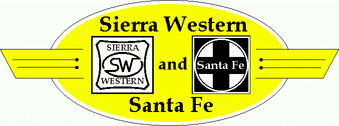
|

|

Local Trains
Local trains are still the backbone of the US rail system in the early 1970s. Locals pick up and deliver railcars to individual industries, team tracks, and other locations based on the instructions given on the car-card/waybill combination. Currently on the SW&SF we have three locals.
Although locals are important to the railroad in terms of business, they are lowest-priority in terms of their access to the tracks. All through trains will be considered "superior" by the Dispatcher, so local trains may have long periods of waiting for clearance before they can continue their jobs … all in the interest of keeping the through trains "on time".
Passenger and Expedited Through Freight Trains
Sometimes called "hotshots" or "time freights", these trains are the highest priority freight trains on the system. They tend to move at the same times each day and the Dispatcher will take great pains to keep them on schedule. With rare exceptions, they will stop only in Orchard yard on the visible portion of the layout to swap blocks: dropping off local cars and picking up high priority cars.
Pick-up Trains (a.k.a. "Sweepers" or long distance locals)
These trains travel between terminals, picking-up and dropping-off cars in towns along the way. They do not spot these cars at the local industries (that task is left for the true locals), but simply help move traffic across the system. Their run on the visible layout is just part of day of these trains, which are imagined to be running between Stockton and the division point of Stern (one eastbound and one westbound). These trains have little more glamour than the true locals, but perform a valuable service in keeping the wheels of commerce turning.
Transfer runs
One of the key elements of railroading is the exchange of cars between different railroads. On the SW&SF we currently interchange with the Southern Pacific and the Sacramento Northern (controlled by the Western Pacific) out of Orchard yard. There are two types of transfer runs: inbound, which bring cars to the modeled portion of the layout; and outbound, which take cars off the modeled portion of the layout. In keeping with the rules of the time, transfer runs are "one-way". For example, the SP transfer run only brings in cars bound for the ATSF, it does not take any back, instead returning with only the engine and caboose. Conversely, the ATSF transfer run only carries cars to the SP, it does not bring any back. Inbound transfers originate in Valley staging, run into Orchard Yard, are assisted in dropping off their cars by the yard job, then depart back to Valley staging. Outbound transfers are built by the yard job in Orchard yard, have power and caboose attached, then run to Valley staging. This simulates the delivery of cars to the SP or SN/WP. (Because of limited trackage to perform run-arounds in staging, these outbound runs do not return to the modeled layout during the session).
Sacramento Northern/WP Inbound
Haulers (called as needed)
Occasionally the prototype railroads consolidate large numbers of cars to move from one major yard to another as "drag freight". This can help the real railroad "unclog" yards and keep traffic flowing. On many railroads, this type of train is called a "hauler". On the SW&SF, we have these trains available to help move "long east" and "long west" cars as needed. Two of these trains are built in Orchard yard and are called when the Tower Operator (acting temporarily as freight agent) notices a large number of cars bound for destinations off the layout. By calling the Dispatcher, a crew can be arranged to man a hauler. The third hauler would be called only if there was an imbalance of cars in the Portland staging yard. It allows a crew to quickly gather EB traffic and get it out of the staging yard to clear up excess traffic. These trains are only called "as needed", so they may not run in a particular session, depending on traffic patterns.
Yard Duties
Carcards, Waybills and Session Setup

|
|
These pages Designed and Maintained by: Moseley & Associates
For Web Page Information contact: Moseley & Associates
Please send all comments to: Rick Fortin